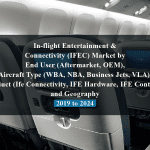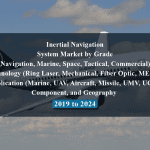OVERVIEW
The Global Antenna Transducer and Radome (ATR) Market is calculated to reach USD 14.43 billion by 2024, continue to grow at a CAGR of 9.69% during the forecast period 2019-2024. Factors such as improvements in sonar and sensor technologies to boost the market for defense transducers, and modernization programs related to defense antennas are propelling the growth of the antenna, transducer, and radome market.








TABLE OF CONTENT
1 Global Antenna Transducer and Radome (ATR) Market
1.1 Study Objectives
1.2 Market Definition
1.3 Study Scope
1.3.1 Markets Covered
1.3.2 Geographic Scope
2 RESEARCH METHODOLOGY
2.1 Research Data
2.1.1 Secondary Data
2.1.1.1 Key Data From Secondary Sources
2.1.2 Primary Data
2.1.2.1 Key Data From Primary Sources
2.1.2.2 Key Industry Insights
2.1.2.3 Breakdown of Primaries
2.2 Market Size Estimation
2.2.1 Bottom-Up Approach
2.2.2 Top-Down Approach
2.3 Market Breakdown and Data Triangulation
2.4 Research Assumptions
3 Global Antenna Transducer and Radome (ATR) Market – Executive Summary
3.1 Market Revenue, Market Size and Key Trends by Company
3.2 Key Trends by type of Application
3.3 Key Trends segmented by Geography
4 Global Antenna Transducer and Radome (ATR) Market – Comparative Analysis
4.1 Product Benchmarking – Top 10 companies
4.2 Top 5 Financials Analysis
4.3 Market Value split by Top 10 companies
4.4 Patent Analysis – Top 10 companies
4.5 Pricing Analysis
5 Global Antenna Transducer and Radome (ATR) Market – Industry Market Entry Scenario
5.1 Regulatory Framework Overview
5.2 New Business and Ease of Doing business index
5.3 Case studies of successful ventures
5.4 Customer Analysis – Top 10 companies
6 Global Antenna Transducer and Radome (ATR) Market – Market Forces
6.1 Introduction
6.2 Market Dynamics
6.2.1 Drivers
6.2.2 Opportunities
6.2.3 Challenges
6.3 Porters Analysis of Market
6.3.1 Bargaining power of suppliers
6.3.2 Bargaining powers of customers
6.3.3 Threat of new entrants
6.3.4 Rivalry among existing players
6.3.5 Threat of substitutes
7 Global Antenna Transducer and Radome (ATR) Market – Strategic Analysis
7.1 Value Chain analysis
7.2 Product Life Cycle
7.3 Supplier and distributor analysis (Market share and product dealing strategies)
8 Global Antenna Transducer and Radome (ATR) Market – By Product (Market Size – &million/billion)
8.1 Antenna
8.2 Transducer
8.3 Radome
9 Global Antenna Transducer and Radome (ATR) Market – By Technology
9.1 Radar
9.2 Communication
9.3 Sonar
10 Global Antenna Transducer and Radome (ATR) Market – By Cost
10.1 Defense Application
10.2 Aerospace Application
10.3 Homeland Security Application
11 Global Antenna Transducer and Radome (ATR) Market – By Application
11.1 Defense
11.2 Aerospace
11.3 Homeland Security
12 Global Antenna Transducer and Radome (ATR) Market – By Geography (Market Size – &million/billion)
12.1 Introduction
12.2 North America
12.2.1 US
12.2.2 Canada
12.2.3 Mexico
12.3 Europe
12.3.1 U.K
12.3.2 Germany
12.3.3 Italy
12.3.4 France
12.3.5 Spain
12.3.6 Rest of Europe
12.4 Asia-Pacific
12.4.1 China
12.4.2 Japan
12.4.3 India
12.4.4 South Korea
12.4.5 Rest of APAC
12.5 Rest of the World
12.5.1 South America
12.5.2 Middle East
12.5.3 Africa
13 Global Antenna Transducer and Radome (ATR) Market – Entropy
13.1 New product launches
13.2 M&A’s, collaborations, JVs and partnerships
14 Global Antenna Transducer and Radome (ATR) Market Company Profile (Key Players)
14.1 Market Share, Company Revenue, Products, M&A, Developments
14.2 BAE Systems
14.3 L-3 Communications Holdings Inc.
14.4 Thales S.A.
14.5 Exelis Inc.
14.6 Raytheon Company
14.7 The Boeing Company
14.8 Cobham PLC
14.9 Finmeccanica S.P.A-P
14.10 Lockheed Martin Corporation
14.11 Qinetiq Group PLC
14.12 Company 11 & more
15 Global Antenna Transducer and Radome (ATR) Market – Appendix
15.1 Sources
15.2 Abbreviations













